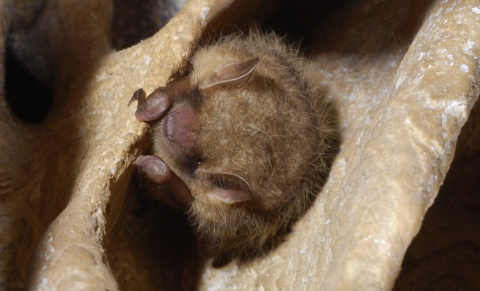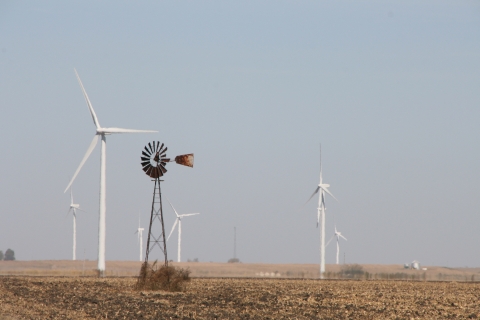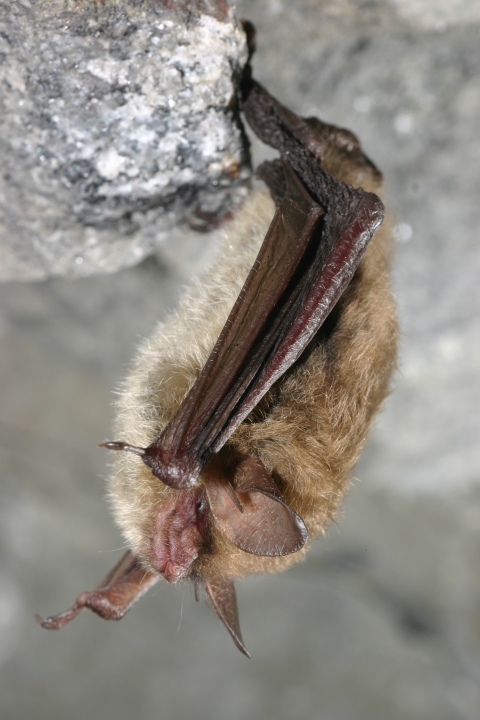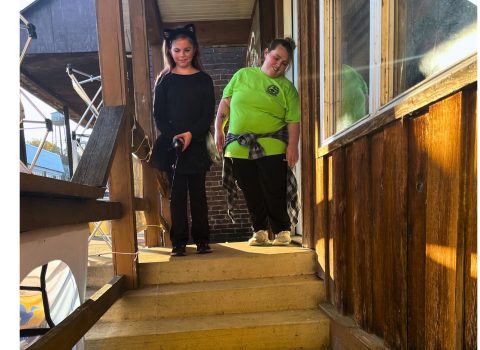The recent reclassification of the northern long-eared bat under the Endangered Species Act and the proposed listing of the tricolored bat presented U.S. Fish and Wildlife Service staff with a novel and immense task: Identify conservation actions that benefit bats and people at a massive scale – including more than 37 states – without creating an equally massive environmental review process. This challenge required the Service to listen closely, collaborate creatively, build trust and adapt its approaches. The result is a set of voluntary final bat conservation tools featuring innovations, technologies and partnerships that offer durable solutions for bat conservation and recovery while supporting economic opportunities.
When a species is listed under the ESA, Section 7 Section 7
Section 7 Consultation
The Endangered Species Act (ESA) directs all Federal agencies to work to conserve endangered and threatened species and to use their authorities to further the purposes of the Act. Section 7 of the Act, called "Interagency Cooperation," is the mechanism by which Federal agencies ensure the actions they take, including those they fund or authorize, do not jeopardize the existence of any listed species.
Learn more about Section 7 of the law requires federal agencies to consult with the Service on any actions they authorize, fund or carry out that may affect a listed species or its designated critical habitat. Non-federal entities are similarly prohibited from incidental take unless authorized by a permit, known as Section 10 exemptions.
Consultations under Section 7 help federal agencies ensure their actions are not likely to jeopardize the continued existence of a listed species or destroy or adversely modify its critical habitat. The Service also provides technical assistance for non-federal projects to understand if project activities are likely to take listed species and therefore need a Section 10 permit. The environmental review and coordination process is specific to each listed species that may be affected and its habitat.
The northern long-eared bat and tricolored bat differ from most species protected or being considered for protection under the ESA, requiring a new approach to coordination. Many listed species have a limited geographic range and/or are threatened by the destruction or modification of a specific type of habitat; neither case applies to these bats. The northern long-eared bat can be found in 37 states; the tricolored bat, in 39. Both species’ declines have been driven by white-nose syndrome, a disease of hibernating bats caused by an invasive fungus that has reduced affected populations of both species by more than 90%, to the extent they are now absent from many places where they used to be found. Taken together, these factors demand that the Service’s approach to environmental review be effective not just for the bats but for the industries, landowners and land management agencies that are responsible for bat habitat across a vast geographic range. The process must also recognize that these bats are now so rare, traditional surveys may fail to locate them even when they are present.
The challenge presents the Service with a novel question: How do you protect remaining northern and tri-colored bat populations when they depend on something as common as trees across an enormous geographic range, and are very difficult to detect?
To answer this question, the Service used location data and modeling to identify areas where bats may be present, using the findings to drive the environmental review process and identify ways to reduce regulatory burden while conserving the species. Drawing on 105+ million records assembled from partners in 50 states, 10 Canadian provinces and 25 Tribal organizations since 2015, the North American Bat Monitoring Program (NABat) has been fundamental to these modeling efforts, identifying not just where these bats historically occurred but also where they endure. This information is then used to predict where bats may intersect with project locations.
Critical to this program’s success are the ongoing contributions of private landowners, industry partners and land management agencies whose data strengthen the predictive tools used in the consultation process and the Service’s ability to pinpoint and conserve areas that most benefit bats. Continuously refining the models simultaneously saves the government and project proponents time and money while conserving bats. The resulting process drastically improves predictability, consistency and preparedness for landowners and project proponents. Industry is a key partner: 180 industry-led projects have contributed over 6.5 million records to the NABat database.
Since the northern long-eared bat consultation tools were launched in March 2023, the Service has run 50,000 projects through the process. More than 90% of those projects required no further interaction by the Service.
The tools and maps that help project proponents evaluate the risk of take are available through the Service’s web-based Information for Planning and Consultation program, known as IPaC. IPaC IPaC
Information for Planning and Consultation (IPaC) is a project planning tool that streamlines the USFWS environmental review process
Learn more about IPaC allows users to cross-reference their project locations quickly and easily against the best available data and drives users with potential for impact to voluntary guidance that helps protect bats and their habitat alongside project activities. For development projects, wind energy and smaller land managers, the Service can immediately clear projects that adopt these voluntary measures, and users can have some predictability about what will be required even before they identify a specific project site. Concurrence letters are automated, and records are automatically updated, requiring minimal oversight by Service staff. The small percentage of projects with anticipated impact to bats are sent to the Service for additional coordination, allowing consultation staff to focus their time where it will have the most benefit.
The voluntary measures are only one way landowners can meet their obligations under the ESA. If a project proponent feels these measures are not well-suited to their operational needs, they can work with Service staff to develop a site-specific Habitat Conservation Plan (or HCP) as an alternative. Through this process, the Service and the project proponent work together to assess the project’s likely impacts on the species, identify steps to avoid, minimize and mitigate those impacts, and assure funding is available to carry out those steps. HCPs can benefit landowners and species by addressing economic development and species conservation simultaneously and in complementary fashion, at a site-specific scale. Since the northern long-eared bat was listed as threatened in 2015, the Service has approved more than 22 HCPs that allow wind energy and forest management projects to proceed after minimizing and mitigating their impacts to the species.
Why the Stakes Are So High for Bats – And for People
Why is all this important? Because bats are important: Their insect-eating prowess saves American farmers more than $3 billion in pest control each year, reducing pesticide use and protecting our health and that of the fields, forests, gardens and waters around us. But when many North American bats settle into hibernation, their winter is overshadowed by the threat of white-nose syndrome. This novel fungal disease emerged around 2006, only affects bats, and is one of the deadliest wildlife diseases on the continent. But impacts aren’t limited just to bats - a recent study found that local bat die-offs from white-nose syndrome triggered a 31% increase in agricultural pesticide use, with documented impacts on human health. While the collaborative white-nose syndrome response effort has assembled experts and researchers who are working at an astounding pace to understand and counteract the declines, including development of several treatments currently being tested, it has not been enough to outpace the impacts of disease. Saving these bats – and in the process, protecting our own health and our environment -- requires protecting the survivors.
Working with Others
Achieving endangered species recovery requires cooperative conservation efforts across a diversity of lands – including federal, state, family-owned, private, non-profit, Tribal and industry lands. Designing guidance and tools for coordination that works across such a broad range of situations requires building relationships and trust, listening to understand, and having the flexibility to adapt while holding true to the conservation needs of each species and the operational needs of each sector.
From the time the interim bat consultation tools were first released in March 2023, the Service has encouraged and incorporated feedback from stakeholders who will use them and conservation organizations who can inform them. The draft consultation tools released for preview in April 2024 benefitted from this early input and invited additional feedback to improve the process and the utility of the final tools and increase their conservation impact.
The Service’s willingness to listen, collaborate creatively, build trust and adapt its approaches has yielded dividends beyond the consultation tools themselves. When the northern long-eared bat was listed as endangered, Corey Schutzman feared the uplisting could trigger as many as 30,000 consultations a year on right-of-way maintenance projects that are routine operations for National Grid, a utility company serving customers in Massachusetts, New York and the United Kingdom. Recognizing the potential impacts and uncertainty across fellow utility companies, Schutzman reached out to Service staff and quickly organized group trainings that opened dialogue and ultimately built strong relationships. “We needed to learn to speak each other’s language, because the nuance of the consultation process was often beyond us,” she said.
Open conversations with Service employees helped utility staff feel empowered to reach out and find responsiveness in navigating bigger issues. “It was a watershed moment to realize that once we understood each other, we could provide meaningful input on both sides,” she said. “Instead of feeling arbitrary and far-reaching, the process feels navigable now, even though it’s still in flux.”
Alliant Energy similarly worked with the Service’s Illinois-Iowa field office to proactively develop an HCP that protects four at-risk bat species across their 700 wind turbines in Iowa and Minnesota, including three species that are candidates or proposed for listing and don’t currently require conservation measures. “We didn’t need to wait on national progress to create a solution,” shares Alan Arnold, program manager for Environmental Renewables. “A collaborative win-win decision, with its clear expectations and a decisive road map, allows us to run our assets with more certainty in knowing that the expert agency agrees with us,” he said of the plan, which Alliant Energy began working on in 2018. “It comes down to developing the relationship, that’s what made this successful,” Arnold said. “When you can call folks who are as approachable as (Service staff) are, you can work through all the details until it works for both parties. We know each other, we trust each other, we follow through and keep going.”
Members of the forest sector, who regularly collaborate with the Service through efforts such as the Wildlife Conservation Initiative, report a similar experience. “After working in the forest sector for more than 30 years, there’s now what I’d consider to be an unprecedented level of trust to pick up the phone and just talk to each other,” said Dr. Darren Miller, vice president of forestry programs for the National Council for Air and Stream Improvement, Inc. “We’re not going to conserve listed species without private lands. If we can get private land conservation right – in a collaborative rather than regulatory way, and based on the best available science – it has the potential to be a truly watershed moment in the history of the conservation movement. And that’s the sense of hope and opportunity that is shared by private landowners and the private sector. It is what can we do together.”
The collaborative and innovative approach the Service has employed in developing and implementing the final bat tools is facilitating bat conservation while addressing the concerns of landowners and industry. The result is a durable conservation partnership that is good for bats and people.













